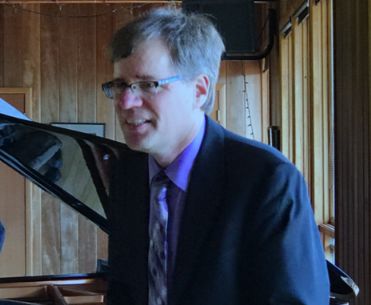|
Symphony
FROM THE NEW WORLD TO THE OLD WORLD
by Peter Lert
Saturday, June 14, 2025
Chamber
MC2 DUO RECITAL CLOSES 222'S SEASON
by Terry McNeill
Saturday, June 14, 2025
Choral and Vocal
CANTIAMO SONOMA'S LUSCIOUS A CAPELLA SINGING IN SEASON ENDING CONCERT
by Pamela Hicks Gailey
Sunday, June 8, 2025
Symphony
SRS SEASON ENDS WITH RESOUNDING TA-TA-TA-BANG
by Terry McNeill
Sunday, June 1, 2025
Symphony
YOUTHFUL VIRTUOSITY ON DISPLAY AT USO'S MAY CONCERTS
by Peter Lert
Saturday, May 17, 2025
Symphony
MYSTICAL PLANETS AND LIVELY GERSHWIN ORTIZ AT FINAL SRS CONCERT
by Peter Lert
Sunday, May 4, 2025
Symphony
VSO'S CONCERT MUSIC OF TIME, MUSIC OF PLACE
by Peter Lert
Sunday, April 27, 2025
VOCAL ELEGANCE AND FIRE AT THE 222'S RECITAL APRIL 26
by Pamela Hicks Gailey
Saturday, April 26, 2025
CANTIAMO SONOMA SINGS AN INSPIRED GOOD FRIDAY MOZART REQUIEM CONCERT
by Pamela Hicks Gailey
Friday, April 18, 2025
DRAMATIC SHOSTAKOVICH SYMPHONY CLOSES PHILHARMONIC'S 25TH SEASON
by Terry McNeill
Sunday, April 13, 2025
|
 |
 Pianist John Novacek After Playing Intoxication Rag July 13 |
NOVACEK'S 2ND HALF TRIFECTA SCORES AT MENDO MUSIC FESTIVAL
by Terry McNeill
Thursday, July 13, 2017
Modern classical piano recitals are in two parts, with longer and perhaps more profound music proceeding perhaps shorter and usually stimulating lighter fare. In John Novacek’s July 13 Mendocino Music Festival recital the best playing came unexpectedly in the eight abbreviated works comprising the second half.
After intermission the Los Angeles-based artist began by choosing two of Shostakovich’s great Op. 87 Preludes and Fugues, the inaugural one from the set of 24 (in C Major) and the monumental D-Flat Major. The Prelude had a beautiful shimmer with bell tones, and heavy pedaling lent an aura of mystery to the drawn-out fugue. In the D Flat the pianist underscored the works sarcasm, and played the complicated fugue in just the right tempo. Mr. Novacek is not a colorist but in the demanding fugue nailed the work’s momentum and excitement.
Excitement continued with Ginastera’s Danzas Argentinas, an early Op. 2 work that has been popular since its 1937 composition. The Danzas del Viejo boyero was marked by agile playing of thirds, with the right hand only on the white keys, and the left hand on the black. and the haunting Danza de la moza donosa had an attractive “swing.” In the toccata-like finale (Danza del gaucho matero) the rhythmic accents are forceful, but the sound was too loud and clarity was lost in the driving ending.
Regarding the overall Preston Hall sound, this year the house piano was moved 180 degrees to the south wall, and somehow this seemingly unimportant instrument placement sporadically amplified Mr. Novacek’s fortissimo chords and upset contrapuntal balances and thematic clarity. But the Ginastera can take a lot of noisy playing, and the audience of 125 responded to the ending’s double glissando with a roar of approval.
Three of the artist’s own rags closed the program – Schenectady, 4th Street and Intoxication. Easy virtuosity and many false cadences were heard in the first, and the artist mentioned that he liked the rhythmic sound of the title. Fourth Street featured small trills and subtle accents that were languorous and charming with slow offbeat accents and subtle dissonances. This street felt hot and humid. He played it wonderfully.
The final work was intoxicating indeed, a roller coaster ride of pulsating sound and whole sections of ragtime sound played with the damper pedal down for bars at a time. Of course such a barnburner piece brought down the house. Surprisingly the energetic ovation did not produce an encore.
Nothing in the playing of the first half’s two works, Beethoven’s Op. 10, No. 2 Sonata, and Schumann’s masterful Op. 9 Carnaval, was in any way ordinary. But for me the sum of all the parts didn’t quite equal a consummate whole. The opening allegro of the F Major (1796) was played aggressively with a careful control of staccato chords and sharply etched phrases. Mr. Novacek caught the humor in the first and especially the last movement, the latter mirroring several of Haydn’s Sonatas. Articulation was crisp and the presto movement's tempo had firm control.
In speaking to the audience prior to the Schumann the pianist related the 1835 work’s creation, and then said he would verbally describe each of the 21 sections as the piece unfolded. Presumably most of the Preston audience found the process helpful, but some quietly decried the loss of small inter-piece connections and musical flow. I found the decision it a misstep, but a small one. More important was Mr. Novacek’s conception of this many-faceted composition, and his is a contemporary conception that spotlighted section architecture and histrionics rather than tone color, rhythmic flexibility and inner voices.
Some of the afternoon’s best playing came in the Papillon, Reconnaissance (fast repetitions) and Paganini sections. Paganini was played with a seco touch, and at a slower-than-usual tempo, and was persuasive. He omitted the mysterious Sphinx section, in contrast to the iconic Rachmaninoff and Cortot recordings. Aveu was played with a singing touch with time for a one patient big inner left-hand voice and layered pedaling at the pianissimo accelerando.
As the work drew down to the big descending chords preceeding the March Against the Philistines, Mr. Novacek produced the one convincing romantic retard in the performance, a delight, but then followed with fast and blurred playing in the March that became a tsunami of notes. Well, Rachmaninoff did the same thing, and generated the same result that presumably the artist wanted. It was propulsive but in the end did not sew up a lyrical, balanced and convincing Carnaval.
|

